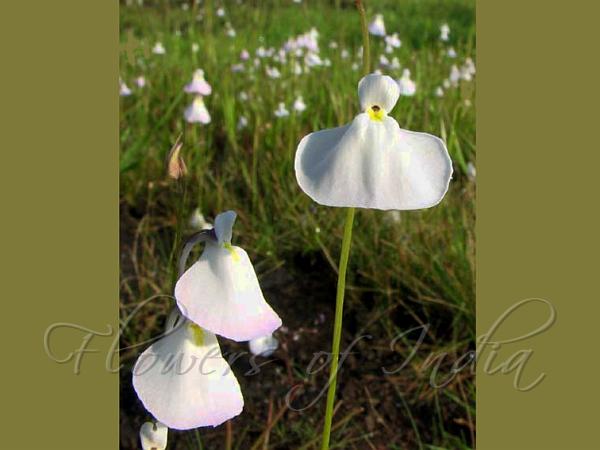|
| White-Blue Bladderwort |
|

|

| File size | 91137 |
| Original date | 10/3/05 8:26 AM |
| Resolution | 756 x 567 |
| Flash | Flash did not fire, auto |
| Focal length | 6.0mm |
| Exposure time | 1/125s |
| Aperture | 8.0 |
| Focus Distance | |
| Metering Mode | Multi-segment |
| Camera make | Canon |
| Camera model | Canon PowerShot S2 IS |
| Sensor type | OneChipColorArea |
|
|
|
|
Photo: |
Botanical name: Utricularia albocaerulea Family: Lentibulariaceae (Bladderwort family)
White-Blue Bladderwort is a carnivorous perennial
herb, found growing in damp soil and on wet rocks. Flowers are 9-13.5
mm long, pinkish blue or occasionally almost white, yellow in throat,
papillose. Upper lip is 4.5-6 x 3-4.5 mm, obovate, notched to flat at
tip. Lower lip is must larger, 9-13 x 11-15 mm, ovate to obovate, hairy
along throat, white and bigibbous at base, flat to ntched at tip. Spur
is 6-9 mm long, conical, slightly curved, pointed at tip. Stamens are
1.5-2.2 mm long. Pistil is 1.5-2.2 mm long, ovary compressed, ovoid;
style distinct, stigma 2-lipped. Flower racemes are up to 15 cm long,
0.8-1 mm thick, erect, simple, grooved, winged, 1-3-flowered..
Flower-stalks are 6-12 mm long, winged, recurved in fruit. Sepals are
ovate, nearly equal, upper 3.8-4.5 x 3-4 mm, long-pointed, rarely
3-toothed at tip, lower sepal 3.2-4 x 2.5-3.4 mm, 2-toothed at tip.
Stems (stolons) are 2-5 cm long, capillary, about 0.2 mm thick,
branched. Leaves are up to 10 x 4 mm, linear to spoon-shaped, at
scape-base and on stolons, 3-nerved, nerves branched further. Traps are
1-1.5 mm across, subdimorphic, those on foliar organs large, elsewhere
small, subglobose. Capsules are about 4.5 x 3 mm, compressed, ovate to
circular in out line. . White-Blue Bladderwort is endemic to the
Western Ghats Flowering: October-December.
Identification credit: Sameer Patil
| Photographed in Belgaum, Karnataka. |